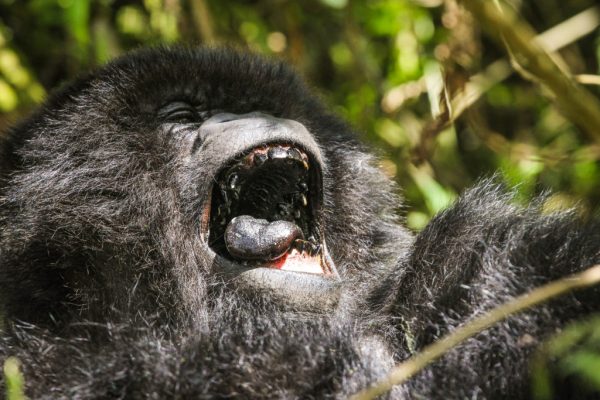Uganda’s biggest tourist draw is indubitably the mountain gorillas, but these aren’t the country’s only great wild animals. By numbers, game viewing is the most popular tourist activity in Uganda. Wild animals like lions, buffaloes, giraffes, antelopes, elephants are common in Uganda’s ten national parks but there are more amazing and less commonly talked about animals that exist in Uganda. At Guide2Uganda, we bring to you the best 10 Amazing Animals to see in Uganda. Check them bellow.
1. Mountain Gorillas
Atop of our list are the Mountain gorillas. These great apes are one of the two subspecies of the eastern gorilla and the largest of the living primates. They have muscular arms, a massive chest, and broad hands and feet. Their thick black hair helps insulate them from cold weather. The gorillas have longer hair and shorter arms than their lowland cousins. However, the world’s largest living primates are under critical threat. About 1,000 of these great apes remain in the wild, according to the most recent census. You can take a Gorilla track for your vacation in the southern national park of Mgahinga and Bwindi to look at these mighty animals. The challenging trek through the steamy jungle of the Bwindi Impenetrable National Park is all worth it once you’re beholding these beautiful beings.
2. African Bush Elephants
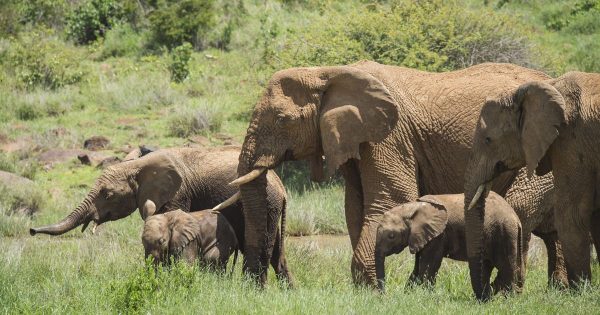 The African bush elephant is an impressive sight; and the largest living terrestrial animal with bulls reaching a shoulder height of up to 3.96 m. A large male can stand 13 feet tall and weigh 11.5 tons, while an average-sized male stands around 10.5 feet tall and weighs 6.6 tons. Both sexes have tusks, which erupt when they are 1–3 years old and grow throughout life. Population numbers of the mighty African Elephant continue to grow in Uganda’s nature reserves and national parks. Catching sight of one of these brilliant beasts while on a game drive is a truly breathtaking experience.
The African bush elephant is an impressive sight; and the largest living terrestrial animal with bulls reaching a shoulder height of up to 3.96 m. A large male can stand 13 feet tall and weigh 11.5 tons, while an average-sized male stands around 10.5 feet tall and weighs 6.6 tons. Both sexes have tusks, which erupt when they are 1–3 years old and grow throughout life. Population numbers of the mighty African Elephant continue to grow in Uganda’s nature reserves and national parks. Catching sight of one of these brilliant beasts while on a game drive is a truly breathtaking experience.
3. Black and White Colobus Monkey
 These curious creatures are fond of grunting, roaring and croaking – so they aren’t hard to find. Look for their white faces in the treetops while walking in Uganda’s national parks. Colobuses are prey for many forest predators, and are threatened by hunting for the bush meat trade, logging, and habitat destruction. Interestingly though, unlike other monkeys, colobus monkeys do not have thumbs. They are strictly leaf-eaters and spend most of their time in treetops, preferring to eat the tender young leaves found there. However, their complex stomachs enable them to digest mature or toxic foliage that other monkeys cannot.
These curious creatures are fond of grunting, roaring and croaking – so they aren’t hard to find. Look for their white faces in the treetops while walking in Uganda’s national parks. Colobuses are prey for many forest predators, and are threatened by hunting for the bush meat trade, logging, and habitat destruction. Interestingly though, unlike other monkeys, colobus monkeys do not have thumbs. They are strictly leaf-eaters and spend most of their time in treetops, preferring to eat the tender young leaves found there. However, their complex stomachs enable them to digest mature or toxic foliage that other monkeys cannot.
4. African Leopard
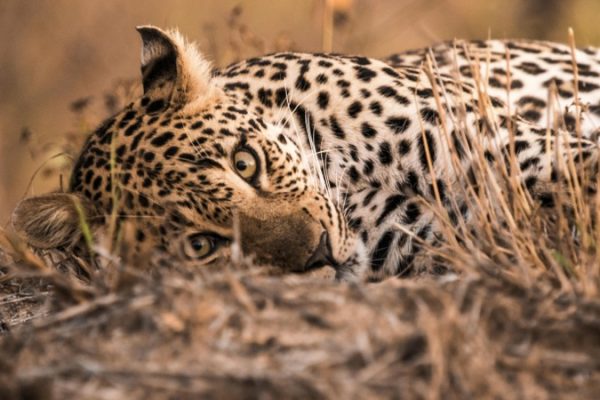 Did you know, the leopard is the most secretive and elusive of all the big cats. These stealthy predators are relatively difficult to spot as they are masters of staying silent and blending in with the scenery. Pound for pound, the leopard is the strongest climber of all the big cats. Their shoulder blades even have special attachment sites for stronger climbing muscles. They spend
Did you know, the leopard is the most secretive and elusive of all the big cats. These stealthy predators are relatively difficult to spot as they are masters of staying silent and blending in with the scenery. Pound for pound, the leopard is the strongest climber of all the big cats. Their shoulder blades even have special attachment sites for stronger climbing muscles. They spend
much of their time in trees even when stalking prey and for eating. Watching a leopard stalk prey is a tense, exciting and riveting experience.
5. African Lions
 Mostly reffered to as the ‘King of the Jungle’, the Lion (Panthera leo) is the second largest cat in the world, following the Tiger. The lion is visibly different from most other cats in that they have a muscular, deep chest with a short but rounded head. Lions are the only cats that live in groups called prides. Lions walk in an unusual manner. Their heels do not touch the ground when a lion walks. This is because they have big toes and pads on the bottom of their feet, which allow them to move quietly. Watching a lion hunt while on a game drive through the parks could be a one in a life time experience.
Mostly reffered to as the ‘King of the Jungle’, the Lion (Panthera leo) is the second largest cat in the world, following the Tiger. The lion is visibly different from most other cats in that they have a muscular, deep chest with a short but rounded head. Lions are the only cats that live in groups called prides. Lions walk in an unusual manner. Their heels do not touch the ground when a lion walks. This is because they have big toes and pads on the bottom of their feet, which allow them to move quietly. Watching a lion hunt while on a game drive through the parks could be a one in a life time experience.
6. Hippopotamus
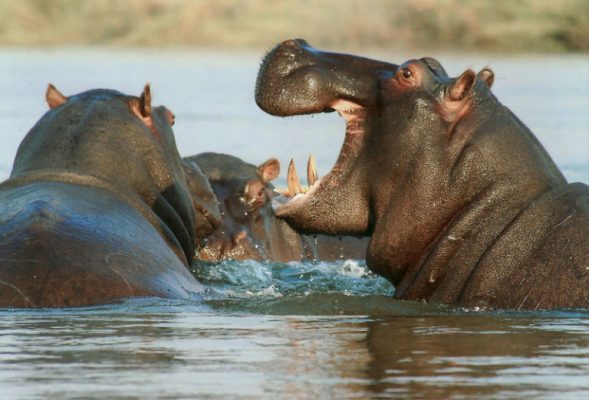 Another gigantic wild creature. Known to spend much of the time in water, surprisingly, hippopotamuses are herbivores and can’t swim or float! They walk or stand on surfaces, like sandbanks, below the water. With a life span is up to 40 years, the great animals are an interesting group to watch as the day goes by to dawn on most lakes, channels and riverine waters with in Ugandan national parks. However, the hippopotamus is one of the most dangerous animals in Africa, as it is highly territorial and aggressive. So you wouldn’t want to get between it and the water!
Another gigantic wild creature. Known to spend much of the time in water, surprisingly, hippopotamuses are herbivores and can’t swim or float! They walk or stand on surfaces, like sandbanks, below the water. With a life span is up to 40 years, the great animals are an interesting group to watch as the day goes by to dawn on most lakes, channels and riverine waters with in Ugandan national parks. However, the hippopotamus is one of the most dangerous animals in Africa, as it is highly territorial and aggressive. So you wouldn’t want to get between it and the water!
7. Chimpanzee
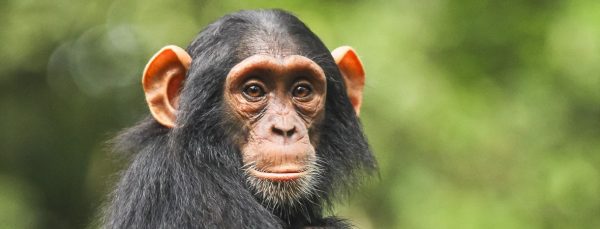 The chimpanzee is another exciting mammal of the ape family. Living in tree canopies and thick vegetations, they are seemingly humble animals lest attacked. Kibale National park and Buddongo are famous habitats to find these mischievous creatures in Uganda. The biggest threats to the chimpanzee are habitat loss, poaching and disease. It’s fun to watch cheeky chimpanzees swinging and playing in unadulterated bliss in the trees of Uganda’s forests.
The chimpanzee is another exciting mammal of the ape family. Living in tree canopies and thick vegetations, they are seemingly humble animals lest attacked. Kibale National park and Buddongo are famous habitats to find these mischievous creatures in Uganda. The biggest threats to the chimpanzee are habitat loss, poaching and disease. It’s fun to watch cheeky chimpanzees swinging and playing in unadulterated bliss in the trees of Uganda’s forests.
8. White Rhinoceros
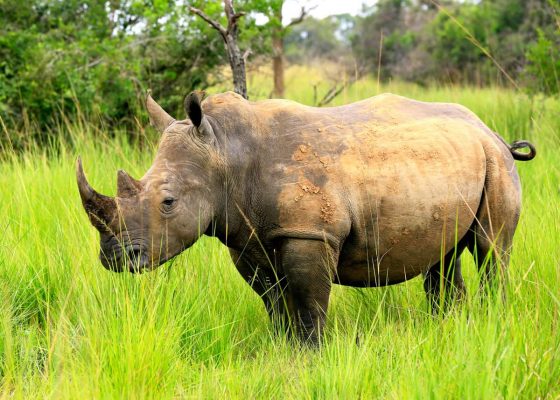 The critically endangered white rhinoceros (Ceratotherium simum) population native to Uganda is one of the country’s biggest attractions for visitors. While rhinos were once widespread in Uganda, intensive poaching has pushed the species near extinction. Rhinoceroses are large, herbivorous mammals identified by their characteristic horned snouts. But wait! White Rhinos Aren’t White. Actually, the word “white” is merely a mispronunciation by English settlers in South Africa of a Dutch word, “wijd,” or wide. The white rhinoceros was described as “wijd” because it has wider lips than the black rhino with its prehensile upper lip. White rhinos are grey.
The critically endangered white rhinoceros (Ceratotherium simum) population native to Uganda is one of the country’s biggest attractions for visitors. While rhinos were once widespread in Uganda, intensive poaching has pushed the species near extinction. Rhinoceroses are large, herbivorous mammals identified by their characteristic horned snouts. But wait! White Rhinos Aren’t White. Actually, the word “white” is merely a mispronunciation by English settlers in South Africa of a Dutch word, “wijd,” or wide. The white rhinoceros was described as “wijd” because it has wider lips than the black rhino with its prehensile upper lip. White rhinos are grey.
9. Lake Victoria’s Cichlids
 What’s a cichlid? Guess this question is running through your mind, right? Hehe! The truth is however, you’re probably more familiar with cichlids than you think. cichlid is a fish that lives in
What’s a cichlid? Guess this question is running through your mind, right? Hehe! The truth is however, you’re probably more familiar with cichlids than you think. cichlid is a fish that lives in
tropical, freshwater and is usually small. See, you knew them. The Lake Victoria Cichilds however are seemingly one of a kind. Despite there being so many different types of these fish, there is not a whole lot of diversity in terms of appearance. There are exceptions to the rule, with some cichlids reaching nearly 3 feet in length and have a more streamlined shape. None the less, If you are looking for cichlids though, Lake Victoria is still the best place to do it.
10. Crested Crane: Uganda’s National Bird
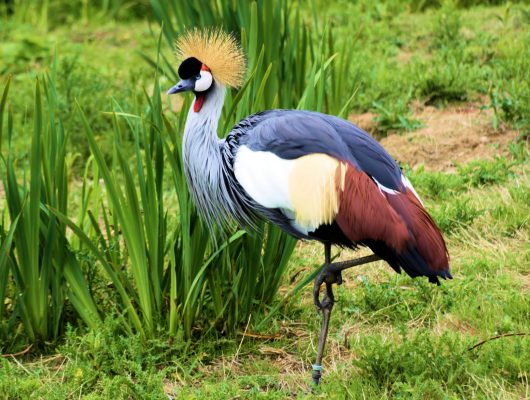 Coming in as our #10 is the humble bird; the crested crane. The Crested Crane is a majestic but obscure bird that few people know about. The Crested Crane is the national bird of the African Nation of Uganda. It appears on their flag and their coat of arms and can be found abundantly near the country’s many lakes and rivers that create fertile marshes rich with wildlife. The African Crested Crane falls under the category of “omnivore”, meaning that like humans, they can eat a combination of both meat and plants. But did you know, Crested Cranes live up to 22 Years. Wow! Catch a glimpse of these wonder birds Around marshy lands of Uganda.
Coming in as our #10 is the humble bird; the crested crane. The Crested Crane is a majestic but obscure bird that few people know about. The Crested Crane is the national bird of the African Nation of Uganda. It appears on their flag and their coat of arms and can be found abundantly near the country’s many lakes and rivers that create fertile marshes rich with wildlife. The African Crested Crane falls under the category of “omnivore”, meaning that like humans, they can eat a combination of both meat and plants. But did you know, Crested Cranes live up to 22 Years. Wow! Catch a glimpse of these wonder birds Around marshy lands of Uganda.
About Guide2Uganda
Guide2Uganda (www.guide2uganda.ug) is the most comprehensive source of information about Uganda that exists on the web, with more content on Uganda and surrounding towns, attractions, museums and galleries than any other online guide that currently exists for Uganda as well as being a dynamic news and comprehensive events driven site with content being added daily.
According to WeFollow & Peer Index (whom both measure online influence) we are among the most influential online media organizations in Uganda. We were also awarded for ‘’Best Destination Website in Uganda’’ by Jumia Travel Uganda in the 2017-2018 Africa Travel Awards. If you are planning a visit to Uganda you can always reach us on; info@guide2uganda.ug

